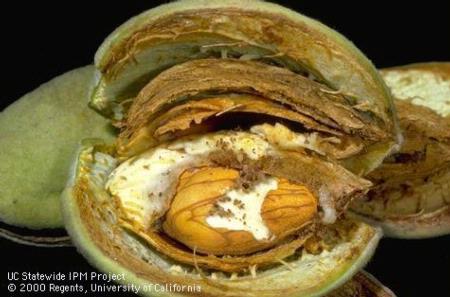
A New Bt Innovation For Worm Pests
Tree nut growers – large/small, conventional/organic – are familiar with Bt, or Bacillus thuringiensis. This spore-forming, gram positive bacterium has played a role in insect pest management since soon after isolation in 1901 by a Japanese biologist investigating a disease of silkworms.
Targeting lepidopteran larvae (caterpillars, loopers, “worms”), EPA has registered commercially available products such as DiPel, Javelin, XenTari and most recently Leprotec, a liquid formulation alternative. Among these are two lep-active subspecies, Bt ssp kurstaki and ssp aizawai.
Acceptance by modern-day growers partially stems from advantages common to most bioinsecticides: 4-hour REI, 0-day PHI and exemption from residue tolerances. Compared to conventional chemistries, Bt products have an excellent safety profile for workers, pollinators, natural enemies and the environment. Furthermore, most meet NOP guidelines for use in organic production.
Bt products also bring a distinct mode of action for managing the development of insecticide resistance. Classified as a Group 11 insecticide, Bt officially operates as a “Microbial Disruptor of Insect Midgut Membranes.” The bacteria produce proteinaceous crystals that are denatured in the digestive tract, liberating toxins that bind to receptors on the midgut surface, forming pores in the membrane, causing ionic imbalance, septicemia, feeding cessation, paralysis and death.
Modern Bt formulations are the outcome of decades of research and discovery. Among thousands of strains, the few commercially available have been carefully selected for efficacy against pest targets. Performance is driven by the Bt strain’s unique Cry toxin profile as well as the quality and quantity of fermentation products yielded by the manufacturing process.
An exciting new innovation in the use of Bt goes well beyond strain selection and fermentation advances. In 2019, EPA approved Spear®-Lep, a bioinsecticide from Vestaron that makes use of Bt’s midgut-disrupting activities to deliver a potent target-specific active ingredient to receptors in the insect nervous system. The active ingredient in this bioinsecticide (a 40-amino acid peptide called GS-omega/kappa-Hxtx), may be 30 times smaller than Bt, but is 10-20 times larger than conventional active ingredients. How to get it to target sites on receptors in the insect nervous system? Tank mix with a low rate of Btk, apply to foliage for ingestion by lepidopteran larvae, and open pathways through the midgut for the Spear peptide.
The partnership between Spear peptide and Btk translates to high performance with much less active ingredient. Add in proven field efficacy (such as against navel orangeworm), plus a novel mode of action (with no cross resistance to current insecticides), and Spear-Lep emerges as a versatile and innovative tool for tree nuts and other high-value field crops.








